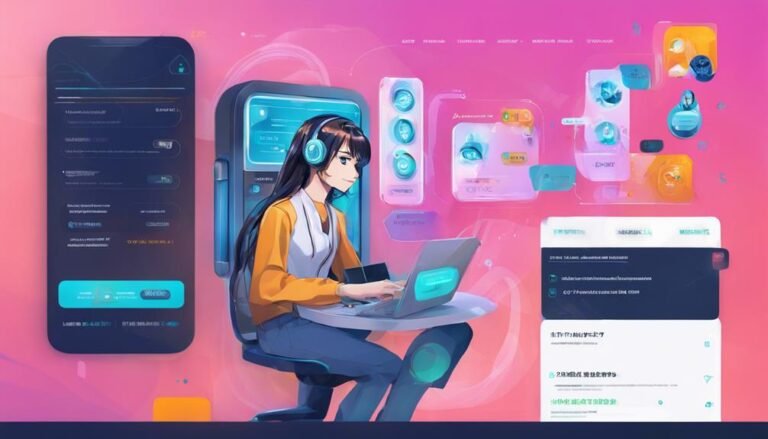What Are Effective Loyalty Programs for Financial Services Clients?
Effective loyalty programs for financial services clients involve utilizing customer segmentation, tiered rewards, VIP benefits, financial education incentives, seamless integration, personalized product recommendations, referral rewards, enhanced security features, and data-driven insights. By tailoring rewards, offering exclusive perks, and emphasizing customer engagement, these programs boost retention rates, satisfaction, and referrals. Clear structures, personalization, and regular evaluation are key elements. Offering personalized financial advice and creating a sense of community foster long-term relationships. Loyalty programs amplify customer lifetime value, reduce acquisition costs, and enhance brand reputation. Implementing these strategies can position your financial services for competitive advantage.
Key Takeaways
- Clear and achievable rewards structure
- Personalization based on customer data
- Seamless integration with existing services
- Multi-channel communication for engagement
- Regular evaluation and adjustment based on feedback
Customer Segmentation for Personalization
When segmenting customers for personalization in loyalty programs for financial services, it's essential to analyze behavioral and demographic data to tailor offerings effectively. Demographic targeting allows financial institutions to group customers based on factors like age, income, education, and occupation. By understanding these demographics, tailored rewards and benefits can be designed to meet the specific needs of each group.
Behavioral analysis is another vital aspect of customer segmentation. By examining how customers interact with financial products and services, institutions can identify patterns that help in customizing loyalty programs. For example, customers who frequently use online banking services may prefer digital rewards, while those who visit branches regularly may appreciate in-person perks.
Psychographic segmentation explores customers' lifestyles, values, and interests. This information helps in creating personalized experiences that resonate with individuals on a deeper level. Geographic customization further enhances personalization by considering regional preferences and trends. By integrating all these segmentation strategies, financial services can optimize their loyalty programs to better engage and retain customers.
Tiered Rewards System
When it comes to the tiered rewards system in loyalty programs for financial services clients, understanding the reward point levels is essential.
By offering clear distinctions between points earned, clients can see their progression towards exclusive benefits.
Tailoring personalized reward options based on these points can enhance client engagement and satisfaction.
Reward Point Levels
To enhance customer engagement and incentivize increased spending, implementing a tiered rewards system with varying reward point levels can be an important approach within loyalty programs for financial services clients.
Bonus point promotions can be utilized to encourage clients to reach higher tiers by offering extra points for achieving specific milestones. These promotions not only motivate clients to spend more but also create a sense of achievement and progress.
Additionally, tier upgrade incentives play a vital role in keeping clients engaged. Offering accelerated point accumulation or exclusive benefits upon tier upgrades can drive clients to aim for the next level, fostering loyalty and satisfaction.
Exclusive Benefits Offered
Implementing a tiered rewards system with exclusive benefits offered can significantly enhance client engagement and loyalty in financial services loyalty programs. By providing personalized promotions and exclusive perks, clients are more likely to feel valued and appreciated, fostering a stronger bond with your institution. Here are key elements to take into account:
- Personalized Promotions: Tailoring promotions based on individual client preferences can increase their sense of being understood and catered to.
- Tiered Benefits: Offering exclusive benefits at different tiers encourages clients to aim for higher levels, increasing loyalty engagement.
- Enhanced Services: Providing unique services such as dedicated customer support for top-tier clients can further solidify their loyalty to your financial institution.
Personalized Reward Options
Incorporating personalized reward options within a tiered rewards system can greatly enhance client engagement and loyalty in financial services loyalty programs. Customized promotions and targeted messaging enable financial institutions to connect with clients on a more personal level, increasing the relevance of rewards offered.
By tailoring experiences to individual preferences, such as providing bonus points for specific financial behaviors or offering discounts on preferred services, clients feel valued and understood. This targeted approach not only fosters a sense of exclusivity but also encourages continued interaction with the loyalty program.
Personalized rewards have been shown to drive higher levels of satisfaction and loyalty among clients, leading to increased retention rates and stronger relationships between financial service providers and their clients.
Exclusive VIP Benefits
When considering Exclusive VIP Benefits, the focus is on providing Premium Perks Selection and Tailored Experience Offerings to your most valued clients.
Premium perks such as personalized financial consultations, exclusive event invitations, and priority customer service can enhance client satisfaction and loyalty to a great extent.
Tailoring experiences to meet individual client needs can lead to a more profound connection with your financial institution, fostering long-term relationships and increasing client retention rates.
Premium Perks Selection
To maximize client engagement and retention in financial services, selecting exclusive VIP benefits as part of premium perks is essential for building long-term loyalty.
Offering luxury experiences and customized rewards can set your loyalty program apart from the competition. Premium perks such as exclusive access to high-end events, personalized financial consultations with experts, and concierge services for travel arrangements can create a sense of exclusivity and value for your VIP clients.
Luxury experiences like private shopping events, tailored investment opportunities, and VIP networking gatherings can make your clients feel special and appreciated. By providing unique and personalized benefits, you can deepen the connection with your high-value clients and increase their loyalty towards your financial services.
Tailored Experience Offerings
Maximizing client engagement and retention in financial services involves offering tailored experience offerings, including exclusive VIP benefits that elevate the client experience and foster long-term loyalty. Customized services play an essential role in creating a sense of exclusivity and personalization for VIP clients. By tailoring services to meet the unique needs and preferences of high-value customers, financial institutions can deepen their relationships and increase loyalty.
Personalized communication further enhances this tailored experience, ensuring that clients feel valued and understood. Through targeted messaging and tailored interactions, financial service providers can strengthen their connections with VIP clients, leading to increased satisfaction and long-term loyalty. By focusing on customized services and personalized communication strategies, financial institutions can create a competitive advantage and drive client retention.
Financial Education Incentives
Implementing targeted financial education incentives can greatly enhance client engagement and loyalty within the financial services sector. By providing educational resources and incentives, financial institutions can empower clients to make informed decisions about their finances, leading to stronger relationships and increased loyalty.
- Financial Literacy Workshops: Hosting interactive workshops on topics like budgeting, investing, and retirement planning can help clients develop essential money management skills.
- Educational Webinars: Offering online webinars presented by financial experts can provide clients with convenient access to valuable financial knowledge from the comfort of their homes.
- Incentive Programs: Rewarding clients for participating in financial education activities, such as completing courses or attending workshops, can further motivate them to engage with these resources and deepen their understanding of financial concepts.
Seamless Integration Across Channels
Achieving seamless integration across channels is vital for optimizing client interactions and enhancing overall user experience in the financial services sector. Providing customers with an omnichannel experience guarantees consistency and convenience, leading to higher satisfaction and loyalty. By integrating various channels such as in-person interactions, online platforms, and mobile applications, financial service providers can cater to diverse client preferences and needs effectively.
| Benefits of Seamless Integration | Description | Impact |
|---|---|---|
| Improved Customer Experience | Guarantees consistent service delivery across all touchpoints | Enhances customer satisfaction and loyalty |
| Increased Digital Engagement | Encourages clients to interact through digital channels | Boosts efficiency and accessibility for clients |
| Enhanced Data Insights | Enables tracking of customer behavior across different channels | Facilitates personalized marketing strategies |
Seamless integration not only streamlines processes but also fosters stronger relationships with clients by offering a cohesive and convenient experience. Embracing digital engagement and providing an omnichannel approach can set financial service providers apart in today's competitive landscape.
Points-Based Redemption Options
To enhance client engagement and incentivize participation, exploring points-based redemption options can be a strategic move for financial service providers looking to maximize customer benefits and loyalty rewards.
When designing a points-based redemption system, consider the following:
- Redemption Flexibility: Offering a variety of redemption options such as cashback, gift cards, travel rewards, or merchandise allows customers to choose rewards that align with their preferences and needs, enhancing their overall satisfaction.
- Personalized Experiences: Tailoring redemption options based on individual customer spending habits and preferences can create a more personalized experience, making clients feel valued and understood by the financial service provider.
- Customer Engagement, Loyalty Retention: By providing diverse and attractive redemption choices, financial institutions can increase customer engagement with the loyalty program, leading to higher retention rates and a more loyal customer base over time.
Tailored Product Recommendations
Consider tailoring product recommendations based on customer data and behavior to enhance engagement and drive personalized financial solutions. By offering personalized recommendations and tailored services, financial institutions can greatly improve customer satisfaction and loyalty. Through the analysis of customer data such as transaction history, spending patterns, and life events, institutions can understand individual needs better and provide targeted promotions and customized solutions. This approach not only increases the relevance of the products and services offered but also demonstrates a deep understanding of the customer's financial goals and preferences.
| Benefits of Tailored Product Recommendations | ||
|---|---|---|
| 1. Enhanced customer engagement | ||
| 2. Increased customer satisfaction | ||
| 3. Improved likelihood of cross-selling |
Implementing a system that automates the process of generating personalized recommendations can streamline the customer experience, making it more convenient and efficient. Additionally, leveraging technology to deliver tailored services demonstrates a commitment to customer-centricity and innovation within the financial services sector.
Referral Rewards Program
Implementing a referral rewards program can greatly enhance customer acquisition and retention rates in the financial services industry. By incentivizing existing clients to refer friends and family, financial institutions can tap into a powerful source of new business. Here's why referral rewards programs are so effective:
- Referral Bonus: Offering a referral bonus to both the existing client and the new client can motivate more referrals. This mutual benefit encourages clients to actively participate in the program.
- Incentive Program: Creating a tiered incentive program where clients receive increasing rewards for each successful referral can drive more engagement. For example, offering a higher bonus for every third referral can incentivize clients to refer more individuals.
- Friend Referral: Leveraging a friend referral system where clients can easily refer their contacts through an online portal or app streamlines the process. Simplifying the referral mechanism increases the likelihood of clients participating in the program.
Enhanced Security Features
Enhanced security features play an essential role in safeguarding financial transactions and protecting client data from potential threats in the digital landscape. Implementing enhanced authentication measures such as biometric verification, multi-factor authentication, and encryption technologies can greatly reduce the risk of unauthorized access to sensitive information. These measures not only provide an added layer of security but also enhance user experience by ensuring seamless yet secure access to financial services.
In addition to enhanced authentication measures, financial institutions employ advanced fraud prevention techniques to detect and mitigate potential risks. Utilizing artificial intelligence and machine learning algorithms, these institutions can analyze vast amounts of data in real-time to identify suspicious activities and prevent fraudulent transactions before they occur. By continuously monitoring and adapting to new fraud patterns, financial service providers can stay one step ahead of cybercriminals and protect both the institution and its clients from financial losses and reputational damage. Investing in robust security systems is vital in today's digital world to build trust and loyalty among clients.
Data-Driven Insights and Analytics
Incorporating data-driven insights and analytics into your loyalty program strategy can greatly enhance customer engagement and retention.
By leveraging customer data, you can tailor personalized offers that resonate with individual preferences and behaviors.
This targeted approach based on data analytics guarantees a higher likelihood of customer satisfaction and loyalty.
Utilizing Customer Data
To optimize the effectiveness of loyalty programs for financial services clients, harnessing customer data through data-driven insights and analytics is vital. Leveraging customer data allows for personalized and targeted strategies that enhance customer engagement and loyalty.
Here's how you can utilize customer data effectively:
- Data Privacy: Maintain compliance with data privacy regulations to build trust with clients.
- Targeted Marketing: Utilize customer data to create personalized marketing campaigns tailored to individual preferences.
- Behavior Analysis: Analyze customer behavior patterns to predict future needs and provide proactive services.
Personalized Offer Strategies
Harnessing customer data through data-driven insights and analytics enables financial service providers to craft personalized offer strategies that foster stronger customer engagement and loyalty. By analyzing customer behavior, preferences, and transaction history, institutions can create customized promotions tailored to individual needs.
Targeted offers based on specific customer segments allow for more personalized interactions, increasing the likelihood of driving desired actions from clients. Utilizing data to understand customer preferences empowers financial service providers to offer relevant products and services, enhancing overall customer satisfaction and loyalty.
This strategic approach not only increases the effectiveness of marketing efforts but also builds long-term relationships with clients by demonstrating a deep understanding of their financial needs and preferences.
Conclusion
By implementing effective loyalty programs for financial services clients, you can access a treasure trove of benefits. Through customer segmentation, tiered rewards, exclusive VIP benefits, and tailored product recommendations, you can create a personalized experience that resonates with your clients.
By utilizing data-driven insights and analytics, you can continuously optimize and enhance your loyalty programs to drive customer engagement and loyalty.
So, dive deep into the world of loyalty programs and watch your client relationships flourish like a well-tended garden.







